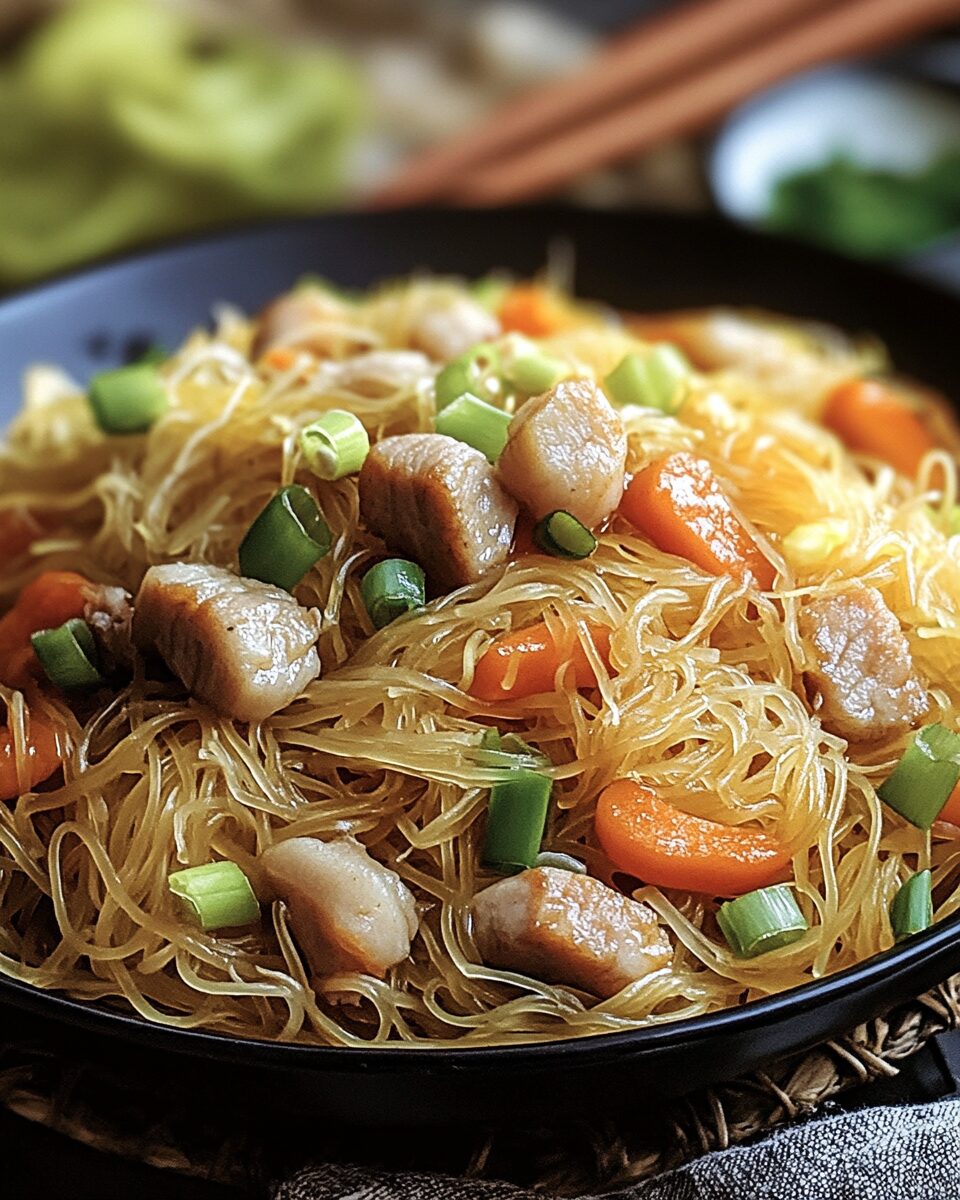Pancit is a quintessential Filipino noodle dish, often served during celebrations as a symbol of longevity and good fortune. This flavorful stir-fry combines noodles with a medley of vegetables and proteins, making it a versatile and beloved comfort food in Filipino cuisine.
FULL RECIPE:
Ingredients:
- 2 tablespoons vegetable oil
- 1 onion, thinly sliced
- 2 cloves garlic, minced
- 1 carrot, julienned
- 1 bell pepper, thinly sliced
- 1/2 cup cabbage, shredded
- 1/2 cup snow peas, trimmed
- 200 grams chicken breast, thinly sliced
- 150 grams shrimp, peeled and deveined
- 2 cups chicken broth
- 2 tablespoons soy sauce
- 1 tablespoon fish sauce (optional)
- 200 grams Pancit Canton noodles
- Salt and pepper, to taste
- Calamansi or lemon wedges, for serving
- Chopped green onions, for garnish
Directions:
- Prepare the Noodles: Cook the Pancit Canton noodles according to package instructions until tender yet firm. Drain and set aside.
- Cook the Proteins: Heat 1 tablespoon of vegetable oil in a large pan over medium heat. Add the chicken slices and cook until no longer pink. Add the shrimp and cook until they turn pink and opaque. Remove both from the pan and set aside.
- Sauté the Aromatics: In the same pan, add the remaining tablespoon of oil. Sauté the sliced onion and minced garlic until fragrant and translucent.
- Stir-Fry the Vegetables: Add the julienned carrot, bell pepper, shredded cabbage, and snow peas to the pan. Stir-fry for 2-3 minutes until the vegetables are tender-crisp.
- Combine Broth and Sauces: Pour in the chicken broth, soy sauce, and fish sauce (if using). Stir well and bring the mixture to a simmer.
- Incorporate Noodles and Proteins: Add the cooked noodles, chicken, and shrimp back into the pan. Toss everything together to ensure the noodles absorb the sauce and the ingredients are evenly distributed. Cook for an additional 2-3 minutes until heated through.
- Season and Serve: Season the Pancit with salt and pepper to taste. Transfer to a serving platter, garnish with chopped green onions, and serve with calamansi or lemon wedges on the side.
Nutrition Facts
- Calories: 352.9 kcal per 235g serving
- Protein: 11.8g
- Total Fat: 11.8g
- Saturated Fat: 2.4g
- Cholesterol: 35.3mg
- Sodium: 941.2mg
- Total Carbohydrates: 52.9g
- Dietary Fiber: 3.5g
- Total Sugars: 2.4g
- Vitamin D: 0 IU
- Calcium: 47.1mg
- Iron: 2.4mg
- Potassium: 235.3mg
Cultural Significance of Pancit
Pancit is one of the most cherished dishes in Filipino cuisine, deeply embedded in the country’s culinary and cultural traditions. This noodle dish is more than just a meal; it carries symbolic meaning, especially in celebrations such as birthdays, fiestas, and family gatherings. The long strands of noodles are believed to represent longevity and good fortune, making Pancit a must-have on special occasions. This belief stems from Chinese culinary traditions, which heavily influenced Filipino cuisine over the centuries. When Chinese traders arrived in the Philippines, they brought with them the tradition of cooking noodles. Over time, Filipinos adapted and modified these dishes using locally available ingredients, resulting in a diverse range of Pancit variations.
Variations of Pancit Across the Philippines
Pancit is not a single dish but rather an umbrella term for a variety of noodle-based dishes in the Philippines. One of the most popular versions is Pancit Canton, which is made using wheat-based egg noodles stir-fried with a combination of vegetables, meat, and seafood. It is often seasoned with soy sauce and other umami-rich ingredients to enhance its flavor. Another widely recognized variant is Pancit Bihon, which uses thin rice vermicelli noodles. This version is known for its light and delicate taste, often paired with chicken, shrimp, and an assortment of vegetables. Unlike Pancit Canton, which has a slightly richer and oily texture, Pancit Bihon is usually drier but just as flavorful. Pancit Malabon, named after the city of Malabon, is a seafood-rich version that features thick noodles coated in a flavorful sauce made from shrimp broth, crab fat, and annatto oil. This dish is often topped with shrimp, squid, boiled eggs, and crushed chicharrón, giving it a unique depth of flavor. Another similar variant is Pancit Palabok, which also incorporates seafood elements but with a thinner type of rice noodles.
The Nutritional Value of Pancit
While Pancit is often considered a comfort food, it also provides several nutritional benefits depending on the ingredients used. The noodles themselves serve as a source of carbohydrates, providing energy for the body. However, the type of noodles can affect the overall nutritional profile of the dish. For instance, rice-based noodles like those used in Pancit Bihon are often lighter and contain fewer calories compared to wheat-based noodles used in Pancit Canton. Protein content in Pancit largely comes from the addition of meat, seafood, or tofu. Chicken and shrimp are common protein sources, providing essential amino acids that contribute to muscle growth and overall body function. Pork and beef are sometimes included in certain variations, though they tend to have a higher fat content. Vegetables play a crucial role in enhancing the nutritional value of Pancit. Ingredients like carrots, bell peppers, cabbage, and snow peas not only add vibrant colors and textures but also contribute vitamins and minerals necessary for a balanced diet. Carrots are rich in vitamin A, which supports good vision, while bell peppers provide a high dose of vitamin C, essential for a strong immune system.
Serving and Pairing Suggestions
Pancit is a highly versatile dish that can be enjoyed on its own or as part of a larger meal. It is commonly served with calamansi or lemon wedges on the side, allowing diners to add a hint of citrusy brightness to balance the flavors. The acidity from the citrus cuts through the richness of the dish, making each bite more refreshing. In traditional Filipino gatherings, Pancit is often accompanied by other staple dishes such as lumpiang shanghai, a type of crispy spring roll filled with ground meat and vegetables. The contrast between the crunchy lumpia and the soft, flavorful noodles creates a satisfying combination. Another popular pairing is with puto, a type of steamed rice cake that offers a mildly sweet contrast to the savory flavors of Pancit. For those who enjoy a bit of spice, adding a side of pickled chilies or chili garlic oil can enhance the overall experience.
Conclusion
Pancit is more than just a noodle dish; it is a representation of Filipino heritage, adaptability, and the communal spirit of sharing food. With its deep cultural significance, rich history, and countless variations, it continues to be a beloved staple in Filipino households. Whether enjoyed during birthdays, fiestas, or simple family dinners, Pancit brings people together through its comforting flavors and meaningful symbolism. Beyond its cultural importance, Pancit offers a well-balanced meal when prepared with the right ingredients.






